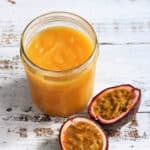Passionfruit Curd
How to make delicious smooth passionfruit curd in the microwave.
Servings 16
Calories 108kcal
Ingredients
- 8 passionfruit pulp and juice (you will need 100 ml passionfruit juice)
- 2 medium free-range eggs
- 150 g caster sugar (superfine sugar)
- 50 g butter
Instructions
- Slice the 8 passionfruit and use a spoon to scrape the pulp and seeds into a bowl. This should yield around 150 ml with the seeds. Then press the passionfruit pulp through a fine sieve into a bowl using the back of the spoon, to remove the seeds. This should yield around 100 ml passionfruit juice.8 passionfruit
- Prepare the rest of the ingredients - weigh out the sugar and butter and get the eggs ready.150 g caster sugar (superfine sugar), 50 g butter, 2 medium free-range eggs
- Add the eggs, sugar, butter to the juice in a large bowl (ceramic or glass for example, that can be used in the microwave).
- Mix using a fork (make sure you beat well so that the eggs are fully combined). Microwave on high for one minute, then beat again with the fork.
- Microwave on high for 2 minutes. Stir well after heating to remove any lumps. You'll see the curd start to thicken up.
- Microwave on high for another minute then stir well. You should now see that the texture of the curd has changed (much thicker) and it has a shiny surfaceCheck if the curd is coating the back of a spoon - dip a spoon into the curd and seeing if it slides off or remains on the back of the spoon. If it coats the spoon then the curd can now be put in the fridge to set, after sieving.Note - if it doesn't coat the spoon yet, heat for another minute, stir then check again.
- Sieve the curd once more to remove any white stringy bits from uneven heating.
- Pour the curd into a sterilised glass jar, put on the lid, and allow to cool fully. Then refrigerate.
Notes
Yield
This recipe will yield one jar of passionfruit curd (324 ml jar size).
Storage
You can store this passionfruit curd for 1-2 weeks in the fridge.
Lumps
If you can see white specks or lumps in your curd this may be from uneven cooking and whisking, where the egg has formed into lumps. Sieve the curd before transferring it to jars to remove them, as stated in the recipe.
How to tell the curd is ready
If it coats the spoon and has a shiny appearance on the surface then this shows the curd is ready to be jarred up. Remember that curd thickens up once it has cooled.
Nutrition
Calories: 108kcal | Carbohydrates: 19g | Protein: 2g | Fat: 3g | Saturated Fat: 2g | Polyunsaturated Fat: 1g | Monounsaturated Fat: 1g | Trans Fat: 1g | Cholesterol: 27mg | Sodium: 40mg | Potassium: 156mg | Fiber: 4g | Sugar: 14g | Vitamin A: 648IU | Vitamin C: 13mg | Calcium: 9mg | Iron: 1mg
